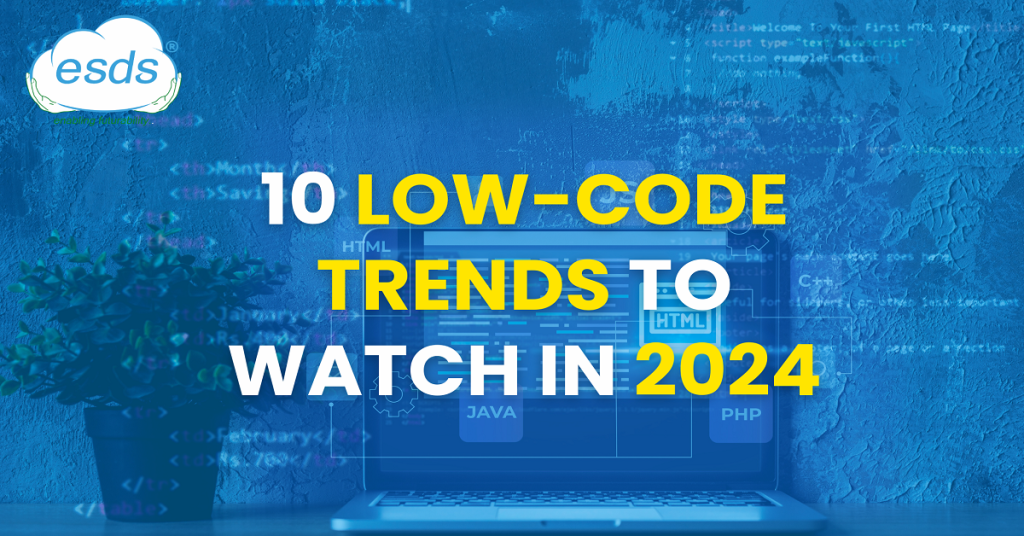10 Low-code Trends to Watch in 2024

Low-code platforms (LCPs)/ Low-code trends have emerged as a game-changer, transforming how businesses build applications. These user-friendly platforms empower local developers, individuals with limited coding expertise, to create custom applications, streamline workflows, and adapt to rapidly changing market demands.
The benefits of low-code trends are numerous, including reduced development time, lower costs, improved scalability, and minimized risk. These advantages have fueled the adoption of LCPs across various industries, giving rise to new use cases such as rapid prototyping, rapid deployment, and new product development.

The increasing demand for agility, innovation, and cost-effectiveness in software development fuels this growth.
Key Low-Code Trends Shaping the Future
Development accessible to everyone
Low-code platforms break down barriers and empower citizen developers to contribute to the application development process. This trend fosters a culture of innovation within organizations, enabling businesses to respond quickly to changing market needs and customer demands.
Increased Adoption by Large Enterprises
Larger enterprises increasingly recognize the value of low-code development, embracing it to accelerate their digital transformation initiatives. As LCPs mature and address enterprise-grade requirements, their adoption will likely expand.
Integration with AI and ML

Integrating artificial intelligence (AI) and machine learning (ML) into low-code platforms unlocks new possibilities. AI-powered features like intelligent code completion, automated testing, and predictive analytics empower citizen developers to build more sophisticated applications without advanced coding skills.
Expansion of Low-Code Trends to Complex Applications
Initially known for their ability to build simple applications rapidly, low-code platforms are evolving to handle more complex projects. Advancements in underlying architectures enable LCPs to address enterprise-level business processes, industry-specific requirements, and complex application development scenarios.
Adoption of Low-Code in Regulated Industries
Industries with strict regulations and compliance requirements, such as finance, healthcare, and government, increasingly embrace low-code development. LCPs are gaining acceptance due to their ability to meet stringent security and compliance standards, enabling the development of compliant applications that adhere to industry-specific regulations.
Integration with DevOps and Agile Methodologies
Low-code platforms seamlessly integrate with DevOps and Agile methodologies, further enhancing their efficiency and agility. This integration enables continuous integration and delivery (CI/CD), enabling faster development cycles, quicker feedback loops, and more responsive software delivery.
Integration with Data Analytics and BI Tools
Integrating low-code platforms with data analytics and business intelligence (BI) tools empowers citizen developers to build data-driven applications. This convergence enables the analysis and visualization of data, identification of patterns, and data-driven decision-making, adding significant value to business operations.
Scalability and Performance
As organizations adopt low-code development for enterprise-level applications, scalability and performance become critical factors. LCPs are evolving to handle larger workloads and ensure optimal performance, meeting the demands of large-scale applications and supporting business growth.
Focus on User Experience (UX)
Low-code applications’ user experience (UX) is paramount for their success. LCP providers prioritize UX design, ensuring that applications are intuitive and user-friendly and provide a positive overall experience for end-users.
Cloud-Native Low-Code Development
Cloud-native LCPs are gaining traction as organizations embrace cloud-based infrastructure. These platforms offer the benefits of scalability, elasticity, and cost-efficiency, making them a compelling choice for cloud-first organizations.
Additional Low-Code Trends to Watch
Low-Code for Security and Governance
LCPs incorporate advanced security and governance features to ensure that applications are developed and deployed securely and competently. This includes access control, data encryption, and audit trails, building trust and confidence in low-code development.
The Future of Low-Code Development
Low-code development is poised to play an increasingly significant role in the future of software development. Its democratizing nature and its ability to address complex business needs drive its adoption across industries and organizations of all sizes. As LCPs evolve and mature, they are poised to revolutionize how software is developed, empowering businesses to innovate faster, adapt more quickly, and thrive in the ever-changing digital landscape.
Impact of Low-Code on Businesses
The adoption of low-code development is profoundly impacting businesses of all sizes. By enabling citizen developers to contribute to application development, organizations can:
- Reduce development time and costs: Low-code platforms significantly reduce the time and resources required to build applications, eliminating the need for extensive coding and specialized expertise.
- Increase agility and innovation: Low-code empowers businesses to respond more quickly to changing market demands and customer needs, fostering a culture of innovation and accelerating time-to-market for new products and services.
- Empower citizen developers: Low-code platforms democratize development, enabling individuals with limited coding experience to contribute to application development. This expands the pool of available developers and empowers businesses to leverage their internal talent more effectively.
- Improve collaboration: Low-code platforms facilitate collaboration between business users, IT departments, and citizen developers, breaking down silos and fostering a more unified approach to application development.
- Enhance productivity and efficiency: Low-code tools streamline development processes, automate repetitive tasks, and reduce manual coding efforts, leading to increased productivity and improved efficiency.
Case Studies of Low-Code Success
Companies across various industries successfully leverage low-code development to achieve their business goals. Here are a few examples:
- PayPal: PayPal utilizes low-code to build internal applications, enabling faster development and empowering citizen developers to contribute to the company’s digital transformation initiatives.
- Siemens: Siemens employs low-code platforms to streamline business processes and develop customer-facing applications, enhancing customer satisfaction and operational efficiency.
- Verizon: Verizon utilizes low-code to build applications for network management, customer service, and internal operations, achieving faster development cycles and improved cost-effectiveness.
- Maersk: Maersk, a global shipping company, uses low-code to develop applications for logistics management, supply chain optimization, and customer relationship management, improving efficiency and reducing operational costs.
- Erste Bank: Erste Bank, a leading financial institution in Austria, leverages low-code to build internal applications for financial processes, customer onboarding, and regulatory compliance, enhancing agility and innovation.
These examples demonstrate the versatility and impact of low-code development across diverse industries.
Conclusion
Low-code development is rapidly transforming the software development landscape, empowering businesses of all sizes to innovate faster, adapt more quickly, and thrive in the ever-changing digital era. With its democratizing nature, scalability, and ability to address complex business needs, low-code is poised to play an increasingly important role in the future of software development. Organizations that embrace low-code development are well-positioned to gain a competitive edge and achieve their business goals.
- Decoding Generative AI: A Comprehensive Guide to Gartner’s Impact Radar - January 2, 2024
- 5 Best Practices for Cloud Security in 2024 - December 29, 2023
- 10 Best Machine Learning Ops Strategies for Cloud Environments in 2024 - December 29, 2023
